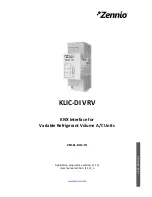
English –
11
EN
3.5 - STOP SAFETY EDGE Input
The function of the SAFETY EDGE input is to cause the immediate stop of a
manoeuvre when in progress followed by a short reverse manoeuvre.
This input can be connected to devices such as optical sensitive edges (OSE)
or those with 8.2 kΩ constant resistance output.
During the recognition phase, the control unit recognises the type of device
connected and causes a “STOP” whenever any variation in the recognised
status occurs.
Multiple devices, even of different types, can be connected to the STOP
SAFETY EDGE input if appropriately organised:
- NO devices: connect the 8.2 kΩ resistor in parallel to the device;
- NC devices: connect the 8.2 kΩ resistor in series to the device;
- You can connect multiple NC devices “in series” with each other without
quantity limits;
- If there are multiple devices, all must be connected “in cascade” with a single
8.2 kΩ terminal resistance;
- You can also create a combination of NO and NC types, by placing the two
contacts “in parallel”. In this case, you need to place a 8.2 kΩ resistance “in
series” with the NC contact; this also makes it possible to put three devices
together: NO, NC and 8.2 KΩ.
3.6 - Connecting a radio receiver
The control unit has an SM connector for connecting an SMXI, SMXIS, OXI,
OXIT or similar radio receiver (optional accessory, not supplied).
To connect the radio receiver, you must disconnect the mains power supply
from the control unit and insert the receiver as shown in
Fig. 14
.
Table 2 shows the actions performed by the control unit according to the acti
-
vated outputs or the commands sent by the radio receiver.
Note - For further information, refer to the instruction manual for the receiver.
V
W
U
L1
L2
L3
14
TABLE 2
SMXI, SMXIS Receiver in “Mode 1 or 2”
output
description
Output No. 1
Step-by-Step
Output No. 2
Partial open;
factory setting
: it opens to halfway (this
may be changed during the position acquisition phase
or by using the Oview programmer)
Output No. 3
Open
Output No. 4
Close
OXI, OXIT receiver programmed in “extended Mode 2”
command
description
Command No. 1
Step-by-Step
Command No. 2
Partial open;
factory setting
: it opens to halfway (this
may be changed during the position acquisition phase
or by using the Oview programmer)
Command No. 3
Open
Command No. 4
Close
Command No. 5
Stop
Command No. 6
Step-by-Step Condominium
Command No. 7
Step-by-Step High priority
Command No. 8
Partial open 2
Command No. 9
Partial open 3
Command No. 10
Open and Lock automation
Command No. 11
Close and Lock automation
Command No. 12
Lock automation
Command No. 13
Release automation
Command No. 14
Timed Courtesy light
Command No. 15
Courtesy light ON/OFF
3.7 - Initial startup and electrical connections test
After supplying power to the control unit, carry out the following checks:
• Verify that the green L2 LED (close to the DIP switches) flashes regularly, with
a frequency of 1 flash per second.
• If the system is equipped with photocells, check that their LEDs flash cor
-
rectly (RX); the type of flashing is not significant because that depends on other
factors.
• Ensure that the red SAFETY LED near the keyboard cable connector is per
-
manently ON (see Safety LED Diagnostics table, Paragraph 5.2).
If any one of these tests fails to comply with requirements, you must discon-
nect the electrical power from the control unit and check the various electrical
connections made previously.
3.8 - Total deletion of the control unit memory
You can delete all the data stored on the control unit and restore it to its original
state with the default settings.
13
3 L
2 L
1 L
U
V
W
1 2
BRAKE
BOOST
b
a
3 L
2 L
1 L
U
V
W
1 2
BRAKE
BOOST
A
B
Содержание D-Pro Action Series
Страница 2: ......




































